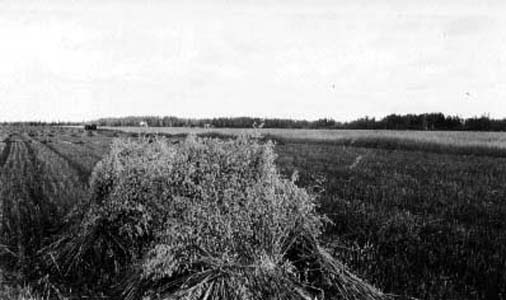Search | Image Archive | Reference | Communities | POV | Lesson Plans | Credits
 Between 1880 and 1920, advances in dryland farming permitted the establishment of a stable agricultural community on the semi-arid Canadian Prairies. Before 1900, farming on the open prairie was a very hit and miss affair, with crops being destroyed by drought or early frost as much as 40% of the time in the dry-belt of southwestern Manitoba.
Between 1880 and 1920, advances in dryland farming permitted the establishment of a stable agricultural community on the semi-arid Canadian Prairies. Before 1900, farming on the open prairie was a very hit and miss affair, with crops being destroyed by drought or early frost as much as 40% of the time in the dry-belt of southwestern Manitoba.
Only with the application of scientific agricultural methods did farming the prairie become a more viable and predictable enterprise. Developments in technology ranged from the introduction of hard spring wheats like Red Fyfe and later Marquis, to seed drilling and the introduction of bluestoning, a chemical treatment which destroyed crop damaging smut.
The most significant advances, however, were made in the area of water conservation. Prairie soil contained marginal levels of moisture, and farmers and researchers expended great efforts to optimize techniques of ploughing, discing and summer fallowing so as to capture and conserve every bit of precipitation.
Finally, dryland farming was accomplished on expansive operations. It was a capital intensive operation which demanded a high level of mechanization. The introduction at the end of the 1880s of steam engines changed the face of ploughing and threshing. The age of steam lasted form 1890 to about 1915, when a new invention, the lightweight and inexpensive gasoline tractor sparked a new revolution that permitted farmers to attain a new level of self-sufficiency.
The development of scientific agriculture in Western Canada in the late nineteenth century was led primarily by Ontario-born agriculturalists in a co-operative effort in which all levels of government participated. It took the form of individual and institutional experimentation led by agricultural institutes, universities, experimental farms, and farmers themselves, who communicated their innovations through the many agricultural periodicals.
Page revised: 27 August 2009